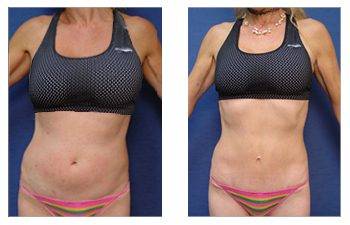What is an apron belly?
An apron belly, also known as a pannus or a mother’s apron, is an accumulation of fat and skin that hangs down over the waistline. This condition can result from factors such as weight gain, weight loss, or pregnancy. Some even call it a C-section shelf! Living with an apron belly can pose numerous challenges, both physically and emotionally. It can lead to discomfort, restricted movement, skin irritation, and insecurity. The impact of an apron belly can also include an increased risk of health complications such as diabetes, heart disease, and back pain. It differs from subcutaneous fat (found under the skin) and visceral fat (found around the organs) and can cause physical and emotional distress. In order to feel more comfortable and confident while living with an apron belly, it is important to focus on self-acceptance and personal care. This can involve practicing self-compassion, seeking support from loved ones, wearing comfortable and well-fitting clothing, and prioritizing mental and physical well-being.

What’s Causes An Apron Belly, and What Can You Do About It?
An apron belly, also known as a pannus, can be addressed through a combination of exercise, diet, laser procedures, and surgery. Incorporating regular abdominal exercises such as crunches and planks can help strengthen the core muscles and reduce the appearance of an apron belly. Additionally, following a balanced diet and maintaining a healthy weight can also aid in minimizing the protrusion of the abdomen. In some cases, laser procedures can be used to tighten the skin and improve its elasticity. For more severe cases, surgical options such as a tummy tuck may be necessary to remove excess skin and fat.
The leading causes of an apron belly include pregnancy, weight loss, and genetic factors. Pregnancy can stretch the abdominal muscles and skin, leading to the development of an apron belly. Significant weight loss can also result in excess skin, creating the appearance of an apron belly. Genetic factors can predispose individuals to carrying excess weight in the abdominal area.
Aging, hormonal conditions, and medical disorders can further contribute to the formation of an apron belly. As individuals age, the skin loses its elasticity, making it more prone to sagging. Hormonal conditions such as menopause can also impact the distribution of body fat, leading to the accumulation of abdominal fat. Certain medical disorders such as Cushing’s syndrome can result in the development of an apron belly due to hormonal imbalances.
What Does a Pannus Stomach Look Like
A pannus stomach refers to an overhanging apron of fat and skin that hangs down from the lower abdomen. It is often large in size and can vary in appearance, ranging from a mild overhang to a more significant and hanging overgrowth of tissue. The pannus stomach is typically located below the belly button and can extend as far down as the thighs. It can cause skin irritation and discomfort due to its size and weight, potentially leading to rashes, sores, or infections.
A pannus stomach is generally formed due to excessive weight gain, obesity, or significant weight loss. Factors contributing to its development include genetics, lack of physical activity, poor diet, and certain medical conditions. The emotional and physical effects of having a pannus stomach can be significant, including low self-esteem, mobility issues, and difficulty maintaining personal hygiene.
Surgical options for reducing or removing a pannus stomach include abdominoplasty (tummy tuck), panniculectomy, and liposuction. These procedures aim to eliminate the excess fat and skin, resulting in a flatter and smoother abdominal area. It is essential to consult with a qualified plastic surgeon to discuss the best option based on individual circumstances.
How can you ease discomfort caused by an apron belly?
To ease discomfort caused by an apron belly, there are several at-home remedies that can help reduce irritation and improve overall comfort.
First, using anti-chafing creams can help reduce friction and irritation in the affected area. Apply the cream to clean, dry skin to create a barrier that prevents chafing.
Additionally, using abdominal support bands or wearing supportive clothing can help alleviate discomfort by providing extra support to the abdomen and reducing strain on the skin.
Maintaining cleanliness and dryness in the affected area is also important in preventing skin irritations. Regularly washing and drying the area can help reduce the risk of infections and discomfort.
It’s important to address both the physical discomfort and the emotional impact of an apron belly to feel comfortable and confident. Utilizing these methods can help ease discomfort and prevent skin irritations, ultimately improving overall well-being.
Can you reduce an apron belly?
An apron belly, also known as a pannus or a hanging belly, can be a source of discomfort for many people due to the excess fat and skin that hangs down over the pubic area. This condition often occurs after significant weight loss or pregnancy and can be difficult to reduce through diet and exercise alone. However, there are various methods and strategies that can help reduce an apron belly, including targeted exercises, surgical options, and lifestyle changes. By implementing these techniques, individuals can work towards reducing the appearance and size of their apron belly, ultimately improving their overall health and confidence.
Lifestyle changes
necessary to reduce pannus stomach. To reduce pannus stomach, it is essential to make significant lifestyle changes, particularly in terms of diet and exercise. First and foremost, it is crucial to eliminate unhealthy, processed, and high-sugar foods from the diet. Instead, focus on increasing the intake of non-starchy vegetables and lean protein, which can help in reducing overall body fat, including the pannus stomach. Small dietary changes should be made one at a time to ensure long-term success.
Regular exercise is also a key component in reducing the pannus stomach. Incorporating both cardiovascular and strength training exercises into a regular routine can aid in burning excess fat and building muscle, which can contribute to a flatter stomach.
Committing to a healthy lifestyle is crucial in reducing pannus stomach. It is important to stay consistent with dietary adjustments and regular exercise, as well as to seek potential medical intervention if necessary.
Overall, by making dietary adjustments, engaging in regular exercise, and committing to a healthy lifestyle, individuals can work towards reducing pannus stomach and improving their overall well-being.
Overview of Surgical Options
When it comes to surgical options, there are a variety of procedures and techniques available to address various medical conditions and improve overall health. From minimally invasive surgeries to complex procedures, this overview will explore the different surgical options and their potential benefits for patients. Whether it’s a traditional open surgery or a cutting-edge robotic-assisted procedure, understanding the range of options available can help patients make informed decisions about their healthcare and seek the best treatment for their specific needs. This overview will provide an informative look at the types of surgical options available, the conditions they can address, and the potential outcomes that patients can expect.
Laser/CoolSculpting procedures
Laser/CoolSculpting procedures are non-invasive treatments aimed at reducing stubborn fat deposits in specific areas of the body. The process involves employing either laser energy or controlled cooling to target and eliminate fat cells. Areas commonly treated include the abdomen, thighs, flanks, back, and under the chin. Important considerations to keep in mind include the importance of consulting with a qualified and experienced practitioner, understanding realistic expectations, and being aware of the potential risks and side effects.
Specific types of people who are not suitable candidates for these procedures include pregnant or breastfeeding individuals, those with certain medical conditions such as cryoglobulinemia or cold agglutinin disease, and individuals with skin conditions or recent surgeries in the targeted area.
Potential risks and side effects associated with Laser/CoolSculpting treatments may include temporary redness, swelling, bruising, and numbness in the treated area. Less common risks include paradoxical adipose hyperplasia, or the enlargement of fat cells, and changes in skin sensation. It is important for individuals to understand these potential risks and consult with their healthcare provider prior to undergoing these procedures.
Panniculectomy
Panniculectomy is a surgical procedure specifically designed to remove excess skin and fat from the abdominal area. This excess tissue, known as a pannus, typically hangs down over the pubic area and can cause discomfort, skin irritation, and hygiene issues. The process of panniculectomy involves making an incision across the lower abdomen, removing the excess skin and fat, and then closing the incision.
Potential candidates for panniculectomy are those who have lost a significant amount of weight, resulting in sagging skin in the abdominal area, or those with excess skin and fat due to pregnancy or other factors. It is important for candidates to be in good overall health and maintain a stable weight before considering this surgery.
It is important to note that panniculectomy is different from a tummy tuck, or abdominoplasty. While both procedures involve the removal of excess skin and fat from the abdominal area, a tummy tuck also includes tightening the abdominal muscles. Therefore, a tummy tuck may be more appropriate for individuals who not only have excess skin but also need to address muscle laxity in the abdominal area.
In conclusion, a panniculectomy is a surgical procedure designed to address excess skin and fat in the abdominal area, and it is best suited for individuals with significant sagging skin without the need for muscle tightening.
Conclusion: Apron Belly
In summary, an apron belly is composed of several factors that result from poor lifestyle choices that result in weight fluctuations. Repeated weight gain and loss and poor soft tissue components will inevitably result in both fat accumulation and poor collagenous support of soft tissue structures resulting in the overhang of skin and soft tissues over the lower belly. When severe, the hanging belly skin resulting apron can literally cover your genitals and cause functional difficulties such as being able to ambulate. Treatments to date have focused on conservative, non-surgical methods such as lifestyle changes or more aggressive invasive surgeries. Regardless, preventing the development of an apron belly should be a high priority as its elimination can be a real struggle. We hope that you have found our discussion of an apron belly helpful.























